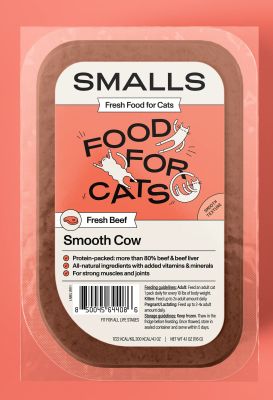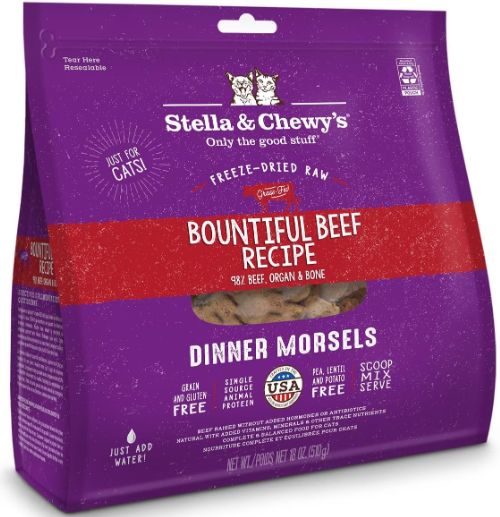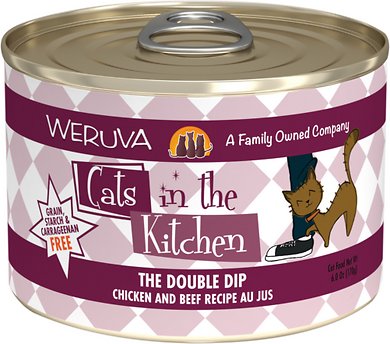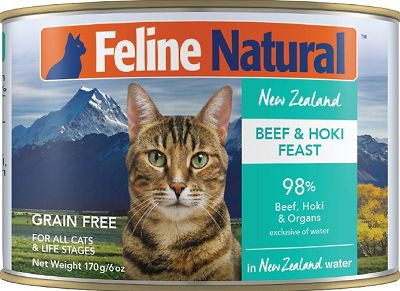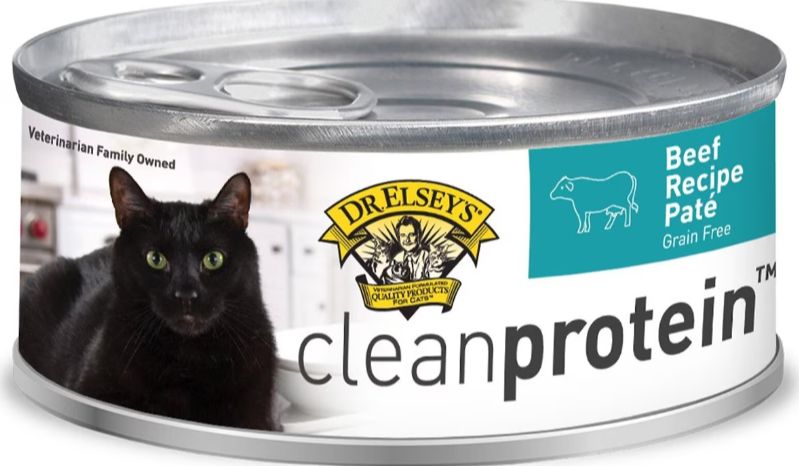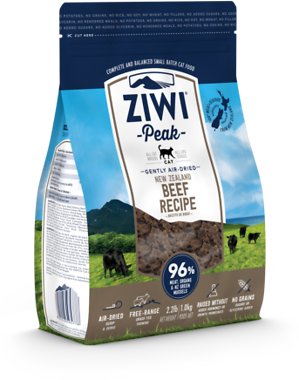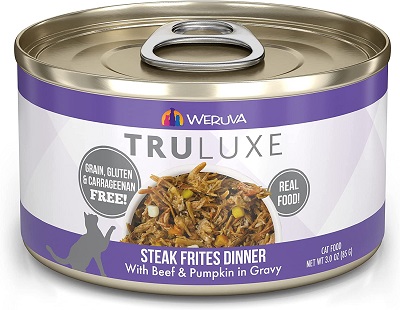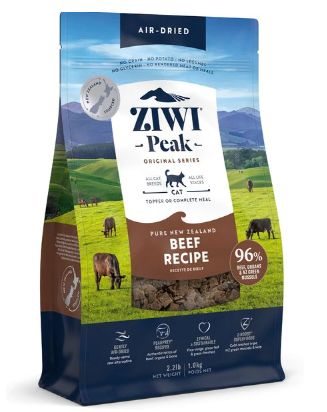
Kate Barrington / Cats.com
The human world consumes over 130 billion pounds of beef each year and the United States accounts for roughly 21% of that figure. Americans love their red meat and you’d be hard-pressed to find a cat who would turn up their nose to it. But is beef healthy for cats?
Here we discuss the nutritional content of beef as well as its pros and cons as part of a feline diet. You’ll also find our top picks for the best beef cat food recipes on the market.
At a Glance: Best Beef Cat Food to Buy





Smalls Smooth Cow Fresh Cat Food
- Made with a single source of animal protein
- Easily digestible with a smooth texture
- Rich in hydrating moisture

Stella & Chewy’s Bountiful Beef Recipe Freeze-Dried Raw Dinner Morsels
- Species-appropriate blend of muscle meat, organs, and bone
- Made with a single protein source
- Very low in carbohydrates

Weruva Cats in the Kitchen The Double Dip Chicken & Beef Au Jus Grain-Free Canned Cat Food
- Four of five main ingredients are animal-based
- Contains over 60% crude protein on a dry matter basis
- Flavorful gravy may appeal to picky eaters
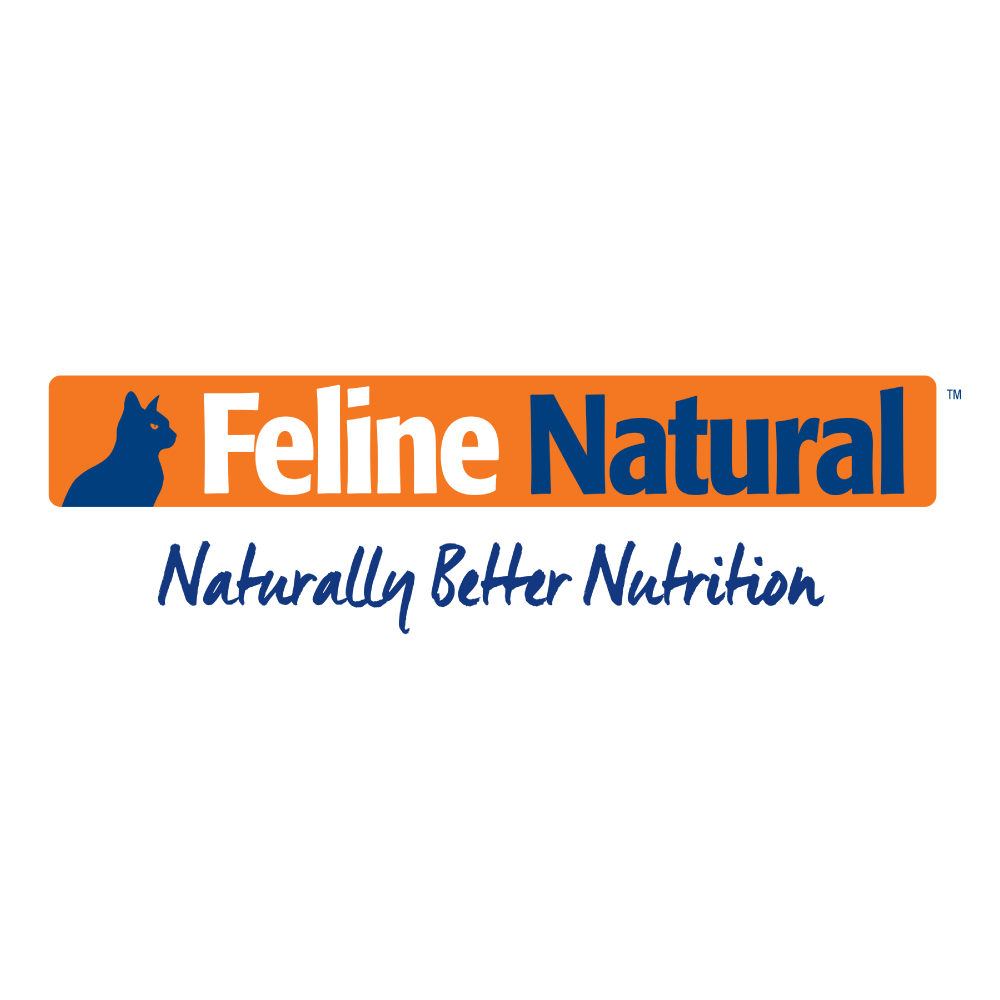
Feline Natural Beef & Hoki Feast Grain-Free Canned Cat Food
- Rich in animal-based protein and healthy fat
- First six ingredients are all animal-based
- Completely free from by-products, fillers, and artificial additives
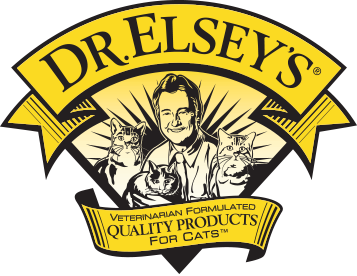
Dr. Elsey’s cleanprotein Beef Formula Grain-Free Canned Cat Food
- Rich in animal-sourced protein and fat
- Contains plenty of animal-sourced omega-3s
- Good source of hydrating moisture

Ziwi Peak Air-Dried Beef Recipe Cat Food
- Provides a concentrated source of protein and nutrition
- Single source of high-quality protein from meat, organs, and bone
- Lower in carbohydrates than the average dry food

Weruva Truluxe Steak Frites Dinner with Beef & Pumpkin in Gravy Grain-Free Canned Cat Food
- Made with a single source of animal protein
- Rich in moisture to support your cat’s hydration
- Low phosphorus content, may support kidney health
Why Trust Cats.com
Before choosing the products featured in this guide, I performed in-depth research and consulted veterinary experts to determine what makes a beef cat food worthy of putting in your cat’s bowl. In addition to reviewing each brand’s history of recalls and customer satisfaction, I read hundreds of customer reviews and analyzed popular recipes.
In addition to completing a comprehensive analysis of the nutritional information for each product, I tested these foods with my own three cats. While they offered input on the food’s flavor and palatability, I observed its smell, consistency, texture, and general appeal. I also made notes about the packaging and compared the guaranteed analysis for several products to the results of chemical analysis, which was performed by an ISO 17025-certified food testing lab and funded by Cats.com.
Our Veterinary Advisors:
- Sarah Wooten, DVM, CVJ
- Chris Vanderhoof, DVM, MPH
- Sarah Reidenbach, DVM
- Chyrle Bonk, DVM
- Jamie Whittenburg, DVM
- Albert Ahn, DVM
- Elizabeth Youens, DVM
Is Beef Good For Cats?
The term beef refers to the meat of cattle (Bos taurus). It comes in many different cuts and can be prepared in an unlimited number of ways from steaks and stews to roasts and burgers. Whereas turkey and chicken are considered poultry (or white meat), beef is considered red meat.
The nutritional content of beef varies from one cut to another simply because some parts of the cow are fattier than others. A 4-ounce serving of ground beef (90% lean) contains about 199 calories, with 22.6 grams of protein and 11.3 grams of fat. It also contains notable amounts of iron, zinc, selenium, phosphorus, and B vitamins.
One of beef’s key nutritional attributes is that it is a complete protein—it contains all 11 of the essential amino acids your cat needs. As a complete protein, beef may be an appropriate foundation for a feline diet, but there are a few things to consider before choosing a beef-based cat food.
1. Beef May Trigger Food Allergies
According to the Cornell College of Veterinary Medicine, food allergies are only the third most common type of allergy seen in cats—secondary to flea allergies and inhalant allergies. While food allergies aren’t exceedingly common, they can develop over time with repeated exposure to the same protein.
Allergic reactions to food can cause a wide variety of symptoms in cats, most of which are skin- or digestion-related. Skin symptoms may include itchy skin, redness or lesions, and hair loss. Digestive symptoms may include vomiting, diarrhea, and loss of appetite. Untreated food allergies can also manifest as recurrent ear infections.
The most common food allergens for cats are chicken, beef, fish, and dairy. While beef may be one of the more prevalent food allergens for cats, however, that’s not to say that allergies to beef are common.
2. It’s Higher in Fat and Calories than Other Proteins
While protein is the most important consideration in a feline diet, don’t forget about fat and calories. Fat contains more calories per gram than protein and carbohydrates, so it’s the most condensed source of energy in your cat’s diet. According to the Association of American Feed Control Officials (AAFCO), both adult cats and kittens require at least 9% crude fat in their diet on a dry matter basis.
But all fat is not created equal. Red meat, like beef, is much higher in fat than poultry and fish. If you’re concerned about your cat’s caloric intake, beef might not be the best choice due to its protein-to-fat ratio. Even if calories aren’t a concern, you may be thinking about the kinds of fat found in beef. Like other red meats, beef is high in saturated fat.
Fortunately, Dr. John Bauer suggests that “although the concept of good and bad fats is appropriate for human health, dogs and cats are able to consume both types of fats in their diets without undue risk of coronary artery diseases, heart attacks, or strokes to which humans succumb. The simplified reason for this is that they have more good cholesterol (HDL) than bad cholesterol (LDL) to begin with, no matter what types of fat they consume.”
That said, beef is not a good source of other fats your cat needs, like omega-3 fatty acids. This problem can be remedied by adding fish oil or other omega-3-rich oils to cat food.
3. Beef Is More Expensive Than Chicken in Cat Food
It’s unwise to shop for cat food by price alone, but affordability is still a valid concern. Chicken is by far one of the most affordable proteins in cat food. Cat food brands can buy it in bulk which makes it more economical for them and for you. Even cat foods that list another protein in the name often have some chicken in them to boost the protein content without significantly affecting the brand’s bottom line.
Beef cat foods tend to be a little pricier than chicken recipes. That largely depends on how much beef is in the food, its quality, and its source.
A single-protein beef recipe is almost certainly going to be more expensive than a recipe that includes beef as one of several proteins. Beef purchased from USDA-inspected human food facilities will be more expensive than beef from less reputable sources. Similarly, cat food made with grass-fed beef may cost more than food made with commercially raised beef.
The Best Beef Cat Foods: Our Top Picks
Our top pick for the best cat food made with beef is Smalls Smooth Cow. Made with 90% lean beef, this fresh food recipe is packed with protein and hydrating moisture. It also contains beef liver which provides biologically appropriate sources of essential vitamins.
While we heartily recommend Smalls fresh food, it isn’t the right choice for every cat. We’ve included a variety of recommendations broken down by type, cost category, and other key considerations. Every cat has unique needs and preferences, so consider your individual cat when making your selection.
Best Beef Cat Food: Comparison Table
| Product Name | Smalls Smooth Cow Fresh Cat Food | Stella & Chewy’s Bountiful Beef Recipe Freeze-Dried Raw Dinner Morsels | Weruva Cats in the Kitchen The Double Dip Chicken & Beef Au Jus Grain-Free Canned Cat Food | Feline Natural Beef & Hoki Feast Grain-Free Canned Cat Food | Dr. Elsey’s cleanprotein Beef Formula Grain-Free Canned Cat Food | Ziwi Peak Air-Dried Beef Recipe Cat Food | Weruva Truluxe Steak Frites Dinner with Beef & Pumpkin in Gravy Grain-Free Canned Cat Food |
| Primary Protein | Beef | Beef | Beef | Beef | Beef | Beef | Beef |
| Guaranteed Protein | 16.50% | 39% | 8% | 9.1% | 9% | 38% | 10% |
| Ash | 2.35% | N/A | 0.97% | 1.60% | 1.81% | 1.50% | 0.48 |
| Calcium | 0.52 | N/A | N/A | 0.4 | 0.27 | 0.4 | N/A |
| Phosphorus | 0.39 | N/A | 0.18% | 0.3 | 0.22 | 0.3 | 0.10 |
| Calories Per Ounce | 49 | 150 | 17 | 27 | 31 | 156 | 21 |
| Cost Per Day | $4.00 | $3.66 | $6.4 | $5.97 | $2.87 | $3.07 | $6.58 |
When shopping for beef cat food, it’s important to know whether you’re looking for a single-protein recipe or not. If your cat has allergies to other proteins, a multi-protein formula might not be the best choice. Single-protein recipes are generally more expensive, but they’re typically made with high-quality ingredients and can be more digestible for cats with tummy troubles.
If your cat has trouble tolerating beef, consider an alternative protein source like turkey, fish, or lamb.
-
The Association of American Feed Control Officials—AAFCO. AAFCO. Published December 4, 2023.
-
Cook R. World Beef Consumption: Ranking of Countries (USDA). Updated December 2023.
-
U.S. Department of Agriculture. FoodData Central. Published April 2019. Accessed October 21, 2023.
